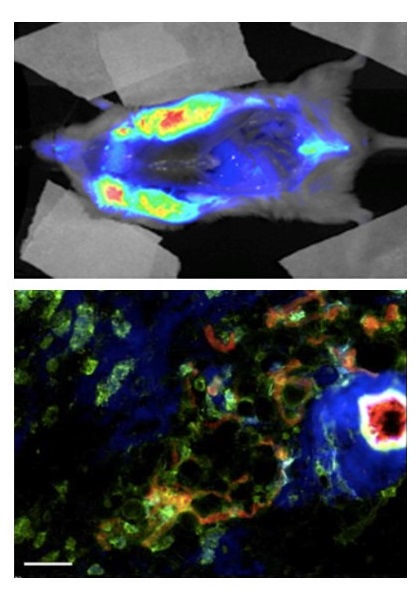Prostate Cancer
Revolutionizing prostate cancer imaging with collagen hybridizing peptide



Posted May 1, 2019
Michael Yu, Ph.D.; University of Utah
Martin Pomper, M.D., Ph.D.; Johns Hopkins University

University of Utah

Johns Hopkins University
One of the most pressing issues in prostate cancer management is the need to predict, at the time of diagnosis, which tumors will remain indolent and which will progress rapidly, ultimately helping patients avoid unnecessary treatment of clinically insignificant disease. Most efforts to identify aggressive disease have focused on specific features of the cancer cells themselves, such as expressed proteins that might be able to act as biomarkers for tumor aggressiveness. However, Dr. Michael Yu at the University of Utah and Dr. Martin Pomper at Johns Hopkins University have discovered a novel way of identifying aggressive prostate cancer by looking at the environment surrounding the tumor cell instead of the tumor cell itself.
In the process of working with collagen hybridizing peptide for tissue engineering, Drs. Yu and Pomper serendipitously discovered that this peptide has an affinity to denatured, or damaged collagen, which has been shown to exist in the microenvironment of cancer cells that have begun to invade and metastasize. Collagen serves as the basic scaffold for cells in most human tissues, including normal prostate tissues, and has been shown to become structurally damaged as cancer cells develop and begin to invade surrounding tissues. Drs. Yu and Pomper realized that with a peptide that has a strong affinity for damaged collagens, they could develop a novel method for detecting damaged collagens that could be used not only for detecting aggressive tumors, but also for drug delivery. With the support from a FY11 PCRP Synergistic Idea Development Award, Drs. Yu and Pomper began working to develop and test a simple molecular probe, now known as collagen hybridizing peptide, or CHP (Bennink LL 2017), for the purpose of detecting aggressive prostate cancer.
After successfully being able to image invasive cancer in an animal model using fluorescent CHP, they have been working to translate these results to humans, which requires application of imaging modalities that are conducive to human use, such as radioactive metals (for PET) and MRI active molecules and nanoparticles. Their initial attempts at producing radioactive CHP encountered challenges with peptide stability and the ability to make multimeric structures out of CHP (by conjugating to polymers or PEG scaffold), but the team has been working on some new strategies for turning CHP into PET and MRI imaging agents and is confident that they will be able to find the right strategy for developing these compounds. Collagen hybridizing peptide has been commercialized for research use (sold by 3Helix Inc), which will better enable further research efforts by this team and others, and may enable to expansion of using collagen peptides for detecting other conditions that are associated with collagen breakdown including arthritis, fibrosis, and osteoporosis. But ultimately, Drs. Yu and Pomper hope that their research will help the many men who will be faced with an uncertain diagnosis of prostate cancer to better enable them to make the appropriate treatment decisions depending on the aggressiveness of their disease.

Figure: In vivo imaging of PC-3 prostate tumors by Collagen hybridizing peptide conjugated to near infrared fluorophore (top image) and corresponding epifluorescence micrographs of PC-3 tumor section (bottom image: CHP in blue).
Publication:
Bennink LL, Smith DJ, Foss CA, et al. 2017. High Serum Stability of Collagen Hybridizing Peptides and Their Fluorophore Conjugates. Molecular Pharmaceutics 14(6): 1906–1915. doi: 10.1021/acs.molpharmaceut.7b00009.
Link:
Imaging Prostate Cancer Microenvironment by Collagen Hybridization
Last updated Thursday, December 5, 2024














